Most people know Sir Winston Churchill for his role as Prime Minister of the United Kingdom from 1940 to 1945. But few know that he was also an avid painter. In this post, I take a closer look at some of his paintings and his life in the arts. I cover:
- Interesting Facts
- A Closer Look at Some of His Paintings
- Words of Advice by Sir Winston Churchill
- Want to Learn More?
- Thanks for Reading!
“Painting is a companion with whom one may walk a great part of life’s journey.” Sir Winston Churchill

(Before diving into this post, make sure to pick up a copy of my free Landscape Painting Starter Kit.)
Interesting Facts
Below are some interesting facts about Churchill’s life in the arts:
- Churchill started painting at the age of 40, shortly after the failed Dardanelles campaign forced his resignation. Overcome with what he referred to as “the black dog” of depression and anxiety, he was encouraged to paint by his sister-in-law, Lady Gwendoline Bertie. In his own words:
“And then it was that the Muse of Painting came to my rescue”. Sir Winston Churchill
- The above quote is from Churchill’s 1921 essay, Painting as a Pastime, which documents his thoughts about art. You can read for free here.
- Fellow artist and friend, Paul Maze, also encouraged Churchill to paint. They would end up being lifelong painting companions and I assume Maze had a strong influence on Churchill’s development in painting. Churchill even wrote the forward for the catalog of Maze’s first New York exhibition in 1939:
“His great knowledge of painting and draughtsmanship have enabled him to perfect his remarkable gift. With the fewest of strokes, he can create an impression at once true and beautiful. Here is no toiling seeker after preconceived effects, but a vivid and powerful interpreter to us of the forces and harmony of Nature”. Sir Winston Churchill on Paul Maze
- He was timid about his skills in painting and insisted he was only a practicing amateur. He even submitted paintings to exhibitions under pseudonyms “Charles Morin” and “David Winter”. In 1947, he only revealed his true identity after two of his paintings were accepted to the summer exhibition at London’s Royal Academy of Arts. A year later in 1948, he was elected by the Royal Academy as Honorary Academician Extraordinary-a remarkable feat for someone who insisted they were just an amateur.
- He was a prolific painter in the latter part of his life, creating over 550 works. No easy feat considering his other achievements in politics and writing.

A Closer Look at Some of His Paintings
Churchill painted mostly impressionist landscapes using oils. Color was clearly his focus, as you can tell from quotes like this:
“I cannot pretend to feel impartial about the colors, I rejoice with the brilliant ones and am genuinely sorry for the poor browns.” Sir Winston Churchill in Painting as a Pastime
He was heavily influenced by many of the top Impressionists like Claude Monet, Paul Cézanne, and Édouard Manet, which you can see in his paintings. The simplified forms, broken color, and overall colorfulness are typical Impressionist traits.
The painting below features an awkward composition, with a man sitting in the bottom left-hand corner looking out over the landscape. There are several strong color shapes in the painting: the light sky, the dull purple mountain in the background, the land around the middle-ground, and the body of water. Churchill’s solid brushwork suggests a calmness in the environment.

The two paintings below are great demonstrations of how to paint reflections in the water. Horizontal strokes of broken color mimic the buildings, trees, boats, and sky.


Although Churchill was not academically trained, he demonstrates skillful drawing in the painting below. Architecture is always a challenge to paint because any mistakes tend to be obvious. Nature is far more forgiving, in that nobody will notice if you paint a tree branch wrong, or forget to paint a cloud in the sky.
The dappled light hitting the building creates an interesting design of light and shadow, breaking up what would otherwise be a rather solid and bland shape.

Below is a challenging subject to paint because of the transparent and reflective nature of water. Not only did Churchill need to capture the blue-green of the water, but he also needed to capture the rocks and sand showing through the water and the colors being reflected. He did a great job in my opinion.
You get a sense of the increasing depth of the river as the colors get deeper and richer. A few clever dabs of light orange and green are enough to capture the broken reflections on the quick-flowing water.

The high-key painting below demonstrates some interesting use of repetition in the trees. It reminds me of some of Monet’s poplars paintings.

Below is one of my favorite paintings by Churchill. Soft, pastel colors were used to depict what I assume to have been a fading sun. There is a strong sense of depth and atmosphere with the layering of colors, from the oranges and yellows just above the horizon line to the blues and purples at the top. Some light orange colors are scumbled on top to suggest light hitting the clouds scattered throughout the sky. The foreground provides some contrast for the pastel sky, with its drab grays, browns, and greens.

Churchill also painted still lifes and interior scenes from time to time, though I do prefer his landscapes.


Words of Advice by Sir Winston Churchill
Below are extracts from Churchill’s Painting as a Pastime essay which I found to be particularly interesting, starting with some wise words of advice for people taking up painting later in life:
“To have reached the age of forty without ever handling a brush or fiddling with a pencil, to have regarded with mature eye the painting of pictures of any kind as a mystery, to have stood agape before the chalk of the pavement artist, and then suddenly to find oneself plunged in the middle of a new and intense form of interest and action with paints and palettes and canvases, and not to be discouraged by results, is an astonishing and enriching experience. I hope it may be shared by others. I should be glad if these lines induced others to try the experiment which I have tried, and if some at least were to find themselves dowered with an absorbing new amusement delightful to themselves, and at any rate not violently harmful to man or beast.”
On the joy of painting:
“Happy are the painters, for they shall not be lonely. Light and color, peace and hope, will keep them company to the end, or almost to the end, of the day.”
“Just to paint is great fun, the colors are lovely to look at and delicious to squeeze out.”
On the challenges of mastering painting:
“When I get to heaven I mean to spend a considerable portion of my first million years in painting, and so get to the bottom of the subject.”

On the struggles of starting a painting:
“Having bought the colors, an easel, and a canvas, the next step was to begin. But what a step to take! The palette gleamed with beads of color; fair and white rose the canvas; the empty brush hung poised, heavy with destiny, irresolute in the air. My hand seemed arrested by a silent veto. At that moment the loud approaching sound of a motor-car was heard in the drive. From this chariot there stepped swiftly and lightly none other than the gifted wife of Sir John Lavery. ‘Painting! But what are you hesitating about? Let me have a brush-the big one.’ Splash into the turpentine, wallop into the blue and the white, frantic flourish on the palette-clean no longer-and then several large, fierce strokes and slashes of blue on the absolutely cowering canvas. Anyone could see that it could not hit back. No evil fate avenged the jaunty violence. The canvas grinned in helplessness before me. The spell was broken. The sickly inhibitions rolled away. I seized the largest brush and fell upon my victim with Berserk fury. I have never felt any awe of a canvas since.”
On using oils over watercolors:
“I write no word in disparagement of watercolors. But there really is nothing like oils. You have a medium at your disposal which offers real power, if you only can find out how to use it. Moreover, it is easier to get a certain distance along the road by its means than by watercolors. First of all, you can correct mistakes much more easily. One sweep of the palette-knife ‘lifts’ the blood and tears of a morning from the canvas and enables a fresh start to be made; indeed the canvas is all the better for past impressions. Secondly, you can approach your problem from any direction. You need not build downwards awkwardly from white paper to your darkest dark. You may strike where you please, beginning if you will with a moderate central arrangement of middle tones, and then hurling in the extremes when the psychological moment comes. Lastly, the pigment itself is such nice stuff to handle (if it does not retaliate).”
On the beauty of nature:
“Once you begin to study it, all Nature is equally interesting and equally charged with beauty.”

Want to Learn More?
You might be interested in my Painting Academy course. I’ll walk you through the time-tested fundamentals of painting. It’s perfect for absolute beginner to intermediate painters.
Thanks for Reading!
I appreciate you taking the time to read this post and I hope you found it helpful. Feel free to share it with friends.
Happy painting!
Dan Scott

Draw Paint Academy

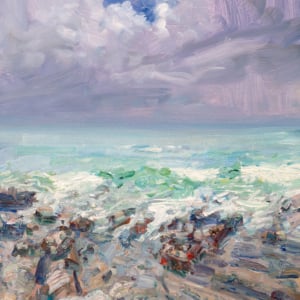
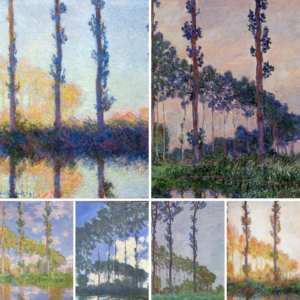
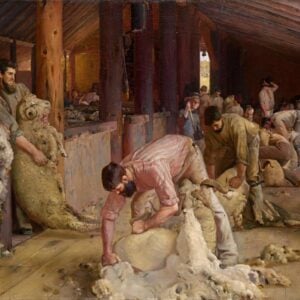
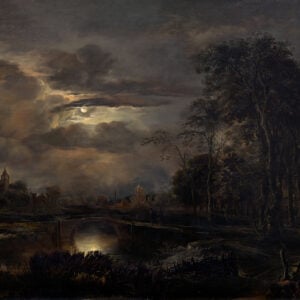
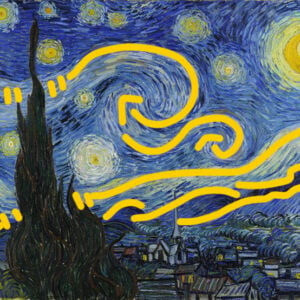
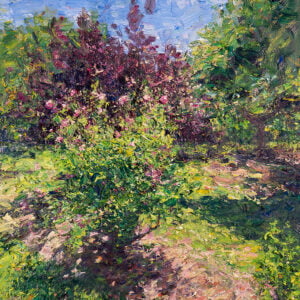
Loved this article and the paintings too. Very inspiring!
Really beautiful paintings
Enjoyed Mr Churchill’s views on painting and comparing it to a armed conflict. He has terrific insight. Loved it as I love about all of your articles.
Loved and appreciated the candor of your article and I am inspired by the paintings presented. Thank you!
Thank you. So very filling. I will reread. Now to work while it’s cool before the heat comes with the bugs. I have time outdoors to search in new ways at colors.
Sich a talented man! Loved this article.
I have had this essay in my library for many years, and I am glad you have made it available for all to read. I admire and appreciate Churchill as an “amateur” painter as much as he was a great statesman. His sentiments about painting ring very true. You selected some wonderful works. I also am looking forward to finding out more about his friend and mentor, Paul Lucien Maze
So interesting and important that Churchill was able to use painting to deal with his ‘black dog’ depression.
Loved the article, who knew? Thanks for letting us learn about Churchill.
love to see these paintings from Winnie!
A really very good article. Thank you !
really enjoyed this article!
A good read Dann – Can I also highly recommend the BBC’s excellent ‘Fake or Fortune’ program which, in one episode, deals with their attempt to establish the validity of an alleged Churchill painting – (available on Netflix)
Thanks for posting. Interesting.
Love this quote:
“Happy are the painters, for they shall not be lonely. Light and color, peace and hope, will keep them company to the end, or almost to the end, of the day.”
And this one on oils:
“You have a medium at your disposal which offers real power, if you only can find out how to use it.”
These were my favorite quotes as well! I didn’t even realize Churchill was an avid painter!
Sometimes a little setback in life, will force you to look for alternative skills and hobbies! The Creator works in interesting ways !
Really enjoyed this. Thanks for sharing it.
I love the colour in The Interior of the Room Near the Window.
And the quote about starting painting later in life is very encouraging to me. I’m 46 and have just now started. 🙂
Thank you for this article!
You learn something every day.idid not know Churchill was so accomplished a painter.excellent article.thank you Dan. Leo
What a lovely article! Thank you.
I didn’t know Sir Winston Churchill was an artist. Thank you for sharing. He was a remarkable statesman as well as artist. His paintings you have shown are beautiful .
Enjoying and learning more from your newsletters!!!
Gloria
What a wonderful article, Dan!!! I had no idea. And what encouraging words this great man gives us amateur painters.
Thanks so much for sharing this. It’s an impetus to keep moving forward with palette and brush in hand.
Awesome piece. I had no idea.
Love Mr Churchill paintings as it is from the region I spent some of my youth there. It lights up great memories. A great man and artist!
I enjoyed this article on Churchill’s paintings very much. Thank you
My first comment on one of your articles. The reason, it was an absolutely intriguing and encouraging piece. Churchill’s books on war and strategy are solid reading for warriors, statesmen and historians. But your article and his treaty on painting actually provide a better look into Churchill himself. Thank you for your effort and quality work!?
What a remarkable man. I am, too, a late in life painter at times intimidated by the blank canvas.
He certainly was talented and this article was inspiring and fun to read.
Thanks for you research.
Hi Dan,
I think this great man could have turned his hand to whatever he wished, and he would have succeeded. Passion and will overcomes many a challenge and he was blessed with both.
Thanks for the post, very enlightening indeed.
Dave M ( Australia)😎🇦🇺
Thanks so much for introducing Churchill’s work and essay to me. Wonderful inspiring words and lovely paintings.
Love the quotes regarding the blank canvas! I get that feeling every time I start with a blank sheet of paper when writing or painting.
Dan, Thank you, so interesting to read and the best quote in the article for me was this:
“From this chariot there stepped swiftly and lightly none other than the gifted wife of Sir John Lavery. ‘Painting! But what are you hesitating about? Let me have a brush—the big one.’ Splash into the turpentine, wallop into the blue and the white, frantic flourish on the palette—clean no longer—and then several large, fierce strokes and slashes of blue on the absolutely cowering canvas. Anyone could see that it could not hit back. No evil fate avenged the jaunty violence. The canvas grinned in helplessness before me. The spell was broken. The sickly inhibitions rolled away. I seized the largest brush and fell upon my victim with Berserk fury. I have never felt any awe of a canvas since.”
I know that feeling of the blank paper to begin a new painting. This is how I wish to feel, just to pick up a brush and begin, I don’t know why I hesitate so long in deciding. Once I begin I’m ok. I enjoy reading all your emails when they drop into my inbox. Margaret
Thank you! I read this several years ago, but somehow rereading it has motivated me to paint mor and paint faster! Time is awasting! I have stared at a blank canvas with a brush in hand and know the feeling of where to begin. There are so many wonderful quotes regarding his art journey. I am 71 and started painting, not avidly about 7 years ago. I wish I had started at age 40. So now I have a lot of catching up to do. I love the quotes. So inspiring! I also love your newsletter.
I had no idea that Churchill was a painter. His paintings are beautiful. As I read and soak in the beautiful artwork I feel that I am transported back in time to a wonderfully and peaceful time. Thank your for sharing this. This is a great way to start my day.
Thank you very much for a very informative article. I was not aware that Sir Winston Churchill was an artist. Loved the quotes.
Hi Dan,
Really nice paintings by Sir Winston Churchill. I loved the flow of words in the article. Thank you for sharing!!
Dan,
So lovely that you shared this with others. I guess I’m one of the lucky ones that has actually been to Chartwell (his English country home) and stood in his studio (another large building away from the manor house) and viewed the many hundred of his paintings that are there. He is one of the those who influenced me begin painting at a later stage in life.
Honestly if you look at his life in historical context and try to realize the stress that he must have been under, I believe painting maybe one of the things that kept him sane, even in the face of failure when there was little hope. Winston Churchill was quite an interesting person and because I have chosen watercolour I often think of his “never, never, never, give up!”as the Mantra I need to repeat! I find your articles so encouraging and helpful.
Thank you, Shonna
I agree with Shonna. What a talented man and an incredible Statesman. Thank you for sharing. What I like about this course is the opportunity to delve deeper into artists lives. To learn about artists I have never heard of. I think painting goes hand in hand with learning about their techniques and having a wider appreciation of art in general. Thank you Dan
Thank you, great article. I was just reading Churchill’s ‘the Second World War’ , a great read. several times in the book, while the tempest gathers and he is a sort of Cassandra to whom no one is listening, he makes very brief mentions of at least having time for the pleasure and solace of painting.
Wow, great article. Actually, i had no idea that the former Prime Minister of the British Empire, Sir Winston Churchill, who had many contributions to politics and WW2, was a talented artist! Thank you for these incredible information.